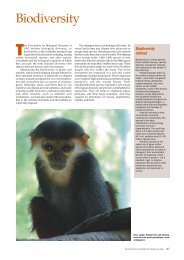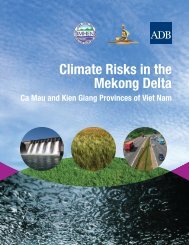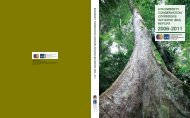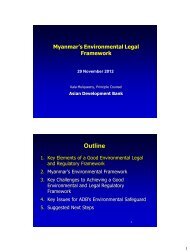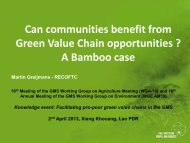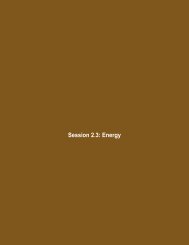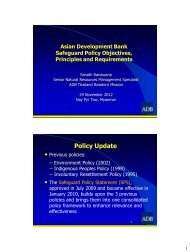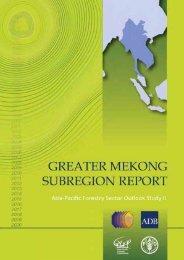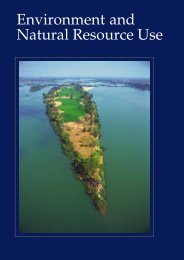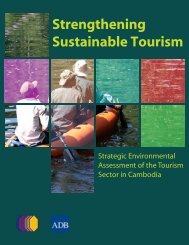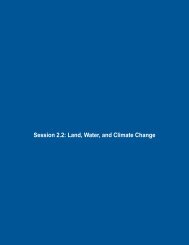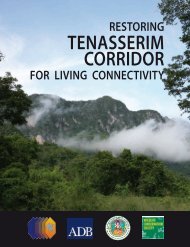What is a Carbon Neutral Transport Corridor? - Greater Mekong ...
What is a Carbon Neutral Transport Corridor? - Greater Mekong ...
What is a Carbon Neutral Transport Corridor? - Greater Mekong ...
You also want an ePaper? Increase the reach of your titles
YUMPU automatically turns print PDFs into web optimized ePapers that Google loves.
<strong>Greater</strong> <strong>Mekong</strong> Subregion<br />
Core Environment Program and Biodiversity Conservation <strong>Corridor</strong>s Initiative<br />
considerable em<strong>is</strong>sions ‘embodied’ in the construction or demolition of such infrastructure or the<br />
em<strong>is</strong>sions that may ar<strong>is</strong>e as an indirect result of the project (e.g. fewer em<strong>is</strong>sions being<br />
sequestered due to deforestation) are rarely considered.<br />
In order to tackle GHGs ar<strong>is</strong>ing from regional initiatives in the GMS, where GHG reduction targets<br />
are not mandatory as yet, a more hol<strong>is</strong>tic approach to carbon neutral projects <strong>is</strong> required. Any such<br />
approach should set clear carbon reduction and offset targets at the outset in order to insure both<br />
elements of the carbon neutral concept are considered.<br />
1.4 Defining the boundaries of carbon neutral transport infrastructure<br />
In order to propose the boundaries and salient features of a <strong>Carbon</strong> <strong>Neutral</strong> <strong>Transport</strong> <strong>Corridor</strong> in<br />
the GMS, it <strong>is</strong> necessary to understand the various sources of em<strong>is</strong>sions that could ar<strong>is</strong>e as a<br />
result of a transport corridor and where the potential carbon savings could be achieved.<br />
For the purposes of th<strong>is</strong> paper, a theoretical transport infrastructure project <strong>is</strong> considered based<br />
loosely on the East West Economic <strong>Corridor</strong> (EWEC) being establ<strong>is</strong>hed across Myanmar,<br />
Thailand, Lao PDR and Viet Nam which cons<strong>is</strong>ts of a number of transport projects being<br />
implemented in different areas to create a unified ‘transport corridor’. The simplified life cycle of<br />
each project would be as follows: the project’s life would begin at the stage where the concept of<br />
the project was first developed and the technical design for the project was completed. The next<br />
stages in the life-cycle would include construction and use of the road transport infrastructure.<br />
Finally, the road and related infrastructure would be upgraded or replaced with newer or different<br />
infrastructure.<br />
An estimate of ‘whole life’ carbon for the infrastructure would need to consider GHGs emitted as a<br />
direct result of the road project at each of the different stages of the life-cycle. However, some of<br />
which may be resource intensive to measure and may not be significant over the lifetime of the<br />
project. Further, apart from the direct em<strong>is</strong>sions associated with the life cycle of the road<br />
infrastructure project, the induced em<strong>is</strong>sions ar<strong>is</strong>ing as a result of the outcomes of a road project<br />
(i.e. better connectivity) should not be d<strong>is</strong>counted. These could vary from increased em<strong>is</strong>sions from<br />
the development that will accompany better transport links and access in the area to increased<br />
em<strong>is</strong>sions attributable to future investments that may occur in the region as a result of better<br />
transport and trade connectivity.<br />
Accounting for and measuring all the various sources of carbon that may be emitted as a result of<br />
one project <strong>is</strong> beyond the scope of th<strong>is</strong> approach, and in reality, may not be necessary. For the<br />
GMS, it <strong>is</strong> important to consider all the significant sources of em<strong>is</strong>sions within the boundaries of a<br />
<strong>Carbon</strong> <strong>Neutral</strong> <strong>Transport</strong> <strong>Corridor</strong> and to understand which areas should be targeted in order to<br />
achieve the greatest reduction in carbon em<strong>is</strong>sions. Table 1 l<strong>is</strong>ts some of the main sources of<br />
Draft Concept Paper – <strong>What</strong> <strong>is</strong> a <strong>Carbon</strong> <strong>Neutral</strong> <strong>Transport</strong> <strong>Corridor</strong>?<br />
25 th November 2010<br />
Page 4





